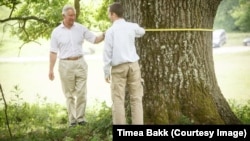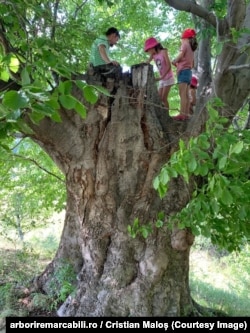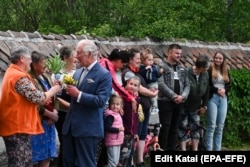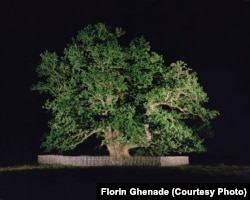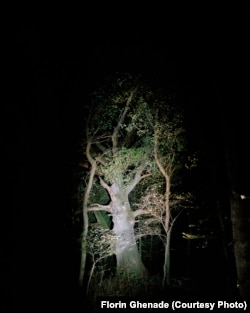BUCHAREST -- In a photograph from 2015, then Prince Charles, smiling and casually dressed in chinos and a white shirt, has one hand on a tape measure as he helps to gauge the circumference of the trunk of a huge oak tree, situated in a lush green pasture in Covasna county in Romania's central region of Transylvania.
The image of the future British king and the giant 250-year-old oak tree, with a circumference of nearly 4.2 meters, was the first entry in a database called the Remarkable Trees Of Romania, which allowed Romanians across the country to upload images of the ancient -- or just important -- trees in their communities.
The image of the Covasna tree is accompanied by Charles's signature and a short description: "The tree is an important part of the tree pasture. It's a veteran tree that deserves respect and love," he wrote in English.
Eight years later, King Charles III has been visiting Romania, his first trip abroad after being crowned on May 6 following the death of his mother, Queen Elizabeth II. After being welcomed by President Klaus Iohannis at the Cotroceni Palace, the presidential residence in Bucharest, the British sovereign spent most of his five-day trip in Transylvania.
King Charles has often spoken fondly of Romania, in particular the country's countryside and wildlife, every spring visiting the properties he owns in Transylvania.
In remarks made upon his arrival in the Romanian capital, he said: "I have come to love Romania -- your culture and art, your heritage and history, your sweeping landscapes and priceless biodiversity…. Romania has retained, in its ancient forests, pristine countryside, and through some remarkable examples of sustainable farming, an incomparable richness of nature."
According to Romanian conservationists, the British king's commitment to the environment, in particular his backing of the tree database project, has helped the passing of a landmark law on protecting the country's trees.
Since the database became fully operational in May 2017, Romanians have uploaded almost 6,000 photos of trees: from the thickest beech in Buzau county; a girthy hornbeam in Brasov county; to a huge black poplar, with a circumference of over 10 meters, in Salaj county.
"We wanted to create a database for old trees, where people can feel empowered to do good for the community, through tourism, educational camps, but also for the trees," says Tibor Hartel, a professor from the Faculty of Environmental Engineering at the Babes-Bolyai University in Cluj and a leading scientific coordinator for the movement to save Romania's trees.
"Our goal was not a law but to popularize old trees. We thought about a law but did not have the confidence that things could materialize. The key factors were NGOs, science, politics -- and more precisely, the younger generation of politicians who feel that doing something for the environment can be included on the political agenda."
Close Relations With Romania
Romania, an EU member since 2007, is home to vast areas of primary forests measuring around half a million hectares. They are mostly situated in the country’s Carpathian Mountains.
King Charles III is known for his environmental activism and, for decades, has advocated organic farming -- including running his own -- the planting of trees, and has spoken out against the dangers of climate change. In 1986, he even said that he liked to talk to his plants to help them grow.
After visiting for the first time in 1998, Charles has developed close relations with Romania and is a popular figure there, largely because of his frequent trips, public championing of the country, and his conservation efforts. He once said that the land was "in his blood."
The British king wasn't just talking metaphorically. Romania's Queen Marie, the wife of King Ferdinand I of Romania, was the first cousin of Britain's King George V, Charles's great-grandfather. Charles's father, Prince Philip, who died in 2021, was a first cousin of Romania's last king, Michael I, who was forced to abdicate by a pro-Soviet government in 1947.
Charles reportedly owns at least 10 properties in Transylvania, a region known for its natural beauty, in particular its sumptuous, tree-lined pastures. Some of the properties were derelict when he bought them and now serve as retreats for tourists wanting to explore the local countryside. In 2015, he set up the Prince of Wales's Foundation Romania, which works with local communities to promote ecotourism, the restoration of traditional buildings, and to support the work of local craftspeople.
The royal interest in Romania's centuries-old trees began, however, not with Charles, but with academic connections between Romanian and British specialists, in particular surrounding the 2014 publication of a book, European Wood-Pastures In Transition: A Social-Ecological Approach, which was edited by tree expert Professor Hartel and Tobias Plieninger, a German professor of social-ecological interactions.
Hartel remembers Sir Charles Burrell, a British baronet, landowner, and conservationist, "[asking] me if I had a dream related to the tree-lined pastures of Transylvania and what it would be. I told him it was to create a database for old trees." As a result, the British baronet -- a royal rank just below baron -- provided financial support to help the database get off the ground.
'Very Much On Topic'
While some Romanian conservationists saw Charles's involvement in the Remarkable Trees Of Romania project as mostly symbolic, Diana Buzoianu, a parliamentary deputy from the liberal Save Romania Union (USR) party and one of the initiators of the newly passed law on trees, said that Charles actually knew the project very well.
During his visit to Romania in May 2022, Charles spoke with Buzoianu about the tree bill then making its way through parliament, which was partly inspired by the platform he helped launch in 2015. "He knew very clearly what he was talking about. It was clear that he knew a lot and cared about the subject," Buzoianu said. "He was very much on topic. He said that we have a huge wealth in Romania -- centuries-old forests and trees -- and that it must be protected."
The cause of preserving Romania's arboreal abundance also inspired artists, such as the photographer Florin Ghenade, who traveled to 80 locations around the country, his pictures culminating in an exhibition called Old Trees, which was shown around the country.
In his travels, Ghenade found ancient trees in pristine condition, but also broken and damaged trees, many gnarled or withered with the passage of time. There was an old oak tree, Ghenade said, "on the edge of the water…[and], if I remember correctly, it was around 400-500 years old" but the tree was blackened, after being set on fire, and had fallen down. The locals, however, still appreciated the tree. "Usually people would use the wood, but the tree was left there and the people in the village talked about it as if it was still standing," Ghenade said.
Ghenade's photos are mostly taken at night, precisely, he said, to attract additional attention. When "you see these trees [only] during the day, it becomes something very familiar, and you don't pay attention to it anymore," he said. "The fact that they are photographed almost without context, with a black and lit background, somehow this short-circuits your attention and makes you ask yourself questions."
In terms of preservation, the most significant step has been the recently passed law, which means that protected trees can only be chopped down under special conditions, if for example they are beyond saving or endangering people.
Trees that meet one of the criteria -- for example, if they are at least 160 years old or reach a certain circumference, depending on type -- are protected. While trees on private property are not covered by the law, owners can be compensated to ensure that ancient trees are not cut down.
In 2021, parliamentary deputy Buzoianu and senator Aurel Oprinoiu, both from the USR party, which was then in power but is now in opposition, introduced the remarkable trees bill in parliament. Adopted in its initial form in October 2021 by the Senate, one of the two houses of the Romanian Parliament, the bill was rejected a year later by a new government, after consultation with the Environment Ministry.
The sponsors of the bill wanted it to also apply to trees in forests, which are overseen by the national forest fund, which manages and regulates the country's private and public forests, including protected zones, and areas for hunting and fishing.
However, according to environmental activist Florin Stoican, the president of the Vacaresti National Park association, "the [Environment] Ministry conditioned their support of the law on its application only to those [trees]" outside the forests and not managed by the national forest fund. The government argued that forest trees were already under various forms of protection, so for those trees the law wasn't needed.
Environmentalists' Concerns
In the end, the paragraph in the proposed law pertaining to trees in Romania's forests was removed before the Chamber of Deputies, the other house of the Romanian Parliament, approved the Law On The Protection Of Outstanding Trees on March 29. Although the law officially entered into force in April, some of the implementation steps have been delayed.
While happy with the passing of the law, some environmentalists are still concerned. It still very much depends on the institutions to do their job, Stoican said. "The next step is to create an (official, state-backed rather than volunteer) database of remarkable trees, where every time someone requests to cut down a tree, it has to be checked to see if it meets one of the criteria in that database." At that point, he said, the felling of such a tree can be stopped and citizens will have a tool at their disposal to challenge the authorities. And in the future, said Hartel, the law will have to be extended to younger trees, which do not yet meet the criteria provided by the law.
For now, many Romanian communities will continue to embrace their remarkable trees. The thickest and oldest oak in Cluj was "adopted" and named Robi by students at one of the city's schools. The students still regularly visit the tree and have placed an information board and a birdfeeder close by.
"[Trees] are primarily a legacy for the communities where they exist," Stoican said. "They are practically the oldest living organisms in their respective communities, and each community should use them as a symbol, an emblem of where they live."




